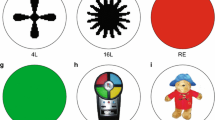Abstract
Six monkeys (Macaca mulatta) learned to discriminate visually between pictures of objects. Each pair of pictures was presented only once per day (24-h intervals between successive trials with the same pair). Choice of the correct picture of a pair produced immediate food reward. One set of 20 pairs was learned before operation and a second set of 20 different pairs was learned after the amygdala had been removed bilaterally in three of the monkeys. The amygdalectomized animals were severely retarded in learning the second set. These results confirm earlier results indicating that amygdalectomy impairs visual discrimination learning in tasks where the discriminanda are directly associated with the incentive value of a primary reward, and they show that, contrary to the indication of some previous results, this impairment extends to the case where each picture is seen only once per day.
Similar content being viewed by others
References
Aggleton JP (1993) The contribution of the amygdala to normal and abnormal emotional states. Trends Neurosci 16:328–333
Barrett TW (1969) Studies of the function of the amygdaloid complex in Macaca mulatta. Neuropsychologia 7:1–12
Baylis LL, Gaffan D (1991) Aniygdalectomy and ventromedial prefrontal ablation produce similar deficits in food choice and in simple object discrimination learning for an unseen reward. Exp Brain Res 86:617–622
Gaffan D (1992a) Amnesia for complex naturalistic scenes and for objects following fornix transection in the Rhesus monkey. Eur J Neurosci 4:381–388
Gaffan D (1992b) Amygdala and the memory of reward. In: Aggleton JP (eds) The amygdala: neurobiological aspects of emotion, memory and mental dysfunction. Wiley, New York, pp 471–483
Gaffan D (1993) Additive effects of forgetting and fornix transection in the temporal gradient of retrograde amnesia. Neuropsychologia 31:1055–1066
Gaffan D (1994) Dissociated effects of perirhinal cortex ablation, fornix transection and amygdalectomy: evidence for multiple memory systems in the primate temporal lobe. Exp Brain Res 99:411–422
Gaffan D, Bolton J (1983) Learning of object-object associations by monkeys. Q J Exp Psychol [B] 35:149–155
Gaffan D, Harrison S (1987) Amygdalectomy and disconnection in visual learning for auditory secondary reinforcement by monkeys. J Neurosci 7:2285–2292
Gaffan D, Lim C (1991) Hippocampus and the blood supply to TE: parahippocampal pial section impairs visual discrimination learning in monkeys. Exp Brain Res 87:227–231
Gaffan D, Murray EA (1990) Amygdalar interaction with the mediodorsal nucleus of the thalamus and the ventromedial prefrontal cortex in stimulus-reward associative learning in the monkey. J Neurosci 10:3479–3493
Gaffan D, Murray EA (1992) Monkeys (Macaca fascicularis) with rhinal cortex ablations succeed in object discrimination learning despite 24-hr intertrial intervals and fail at matching to sample despite double sample presentations. Behav Neurosci 106:30–38
Gaffan D, Gaffan EA, Harrison S (1989) Visual-visual associative learning and reward-association learning: the role of the amygdala. J Neurosci 9:558–564
Gaffan EA, Gaffan D, Harrison S (1988) Disconnection of the amygdala from visual association cortex impairs visual reward-association learning in monkeys. J Neurosci 8:3144–3150
Malamut BL, Saunders RC, Mishkin M (1984) Monkeys with combined amygdalo-hippocampal lesions succeed in object discrimination learning despite 24-hour intertrial intervals. Behav Neurosci 98:759–769
Mishkin M, Petri HL (1984) Memories and habits: some implications for the analysis of learning and retention. In: Squire LR, Butters N (eds) Neuropsychology of memory, 1st edn. Guilford, New York, pp 287–296
Mishkin M, Malamut B, Bachevalier J (1984) Memories and habits: two neural systems. In: Lynch G, McGaugh JL, Weinberger NM (eds) The neurobiology of learning and memory. Guilford, New York, pp 65–77
Murray EA (1992) Medial temporal lobe structures contributing to recognition memory: the amygdaloid complex versus the rhinal cortex. In: Aggleton JP (eds) The amygdala: neurobiological aspects of emotion, memory and mental dysfunction. Wiley-Liss, New York, pp 453–470
Overman WH, Ormsby G, Mishkin M (1990) Picture recognition vs picture discrimination learning in monkeys with medial temporal removals. Exp Brain Res 79:18–24
Author information
Authors and Affiliations
Rights and permissions
About this article
Cite this article
Gaffan, D. Role of the amygdala in picture discrimination learning with 24-h intertrial intervals. Exp Brain Res 99, 423–430 (1994). https://doi.org/10.1007/BF00228978
Received:
Accepted:
Issue Date:
DOI: https://doi.org/10.1007/BF00228978




